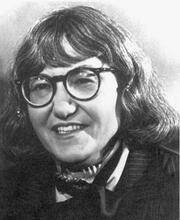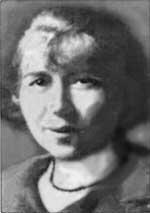Celia Dropkin
Celia Dropkin’s sexually explicit poetry expanded possibilities for the depiction of relationships between men and women in modern Yiddish poetry. Born in White Russia in 1887, Dropkin joined her husband in New York in 1912. Throughout the 1920s and 1930s, Dropkin’s poems appeared in avant-garde Yiddish literary publications. Her poems are infused with erotic energy, and their themes – sex, love and death – shocked her contemporaries. But they were enamored by Dropkin’s angry and passionate poems, which questioned societal assumptions about love. Dropkin was acclaimed by established Yiddish writers as a leading woman poet. She published one book of poems during her lifetime: In Heysn Vint (1935). After Dropkin’s death, her five children sponsored the publication of a new and expanded edition of her poetry, short stories, and paintings in 1959.
The explicitly sexual imagery and themes of Celia Dropkin’s poems redefined the ways modern Yiddish poetry could depict relationships between women and men. Beautifully crafted lyrics, Dropkin’s poems undo the poetic conventions implicit in their very forms and, with their anger and passion, call into question societal assumptions about love. These poems open up a woman’s psyche in a voice that sounds contemporary in the twenty-first century. Even her poems about depression, about mother love, and about nature are infused with erotic energy. Best known for her poetry, Dropkin also published short stories and was an accomplished visual artist.
Early Life & Travels
Celia (Zipporah) Levine Dropkin was born in Bobruisk, White Russia, on December 5, 1887. Her father, Yoysef-Yona Levine, was a lumber merchant who died of tuberculosis when Celia was a young child. Her mother, Feige Levine, from a distinguished family named Golodets, raised and educated Celia and her younger sister, Sima.
Until the age of eight, Celia studied traditional Jewish subjects with a (Yiddish) Rabbi's wife; title for a learned or respected woman.rebbetzin (rabbi’s wife). She also received a secular education from her mother, a woman with artistic sensibility, attending a Russian school in Bobruisk and, later, the high school (gymnasium) in the neighboring city of Novosybko. According to Reysen’s Leksikon, upon graduating from high school, Celia taught school in Warsaw and tutored privately. She wrote poetry in Russian as early as age ten. When she was seventeen, she went to Kiev to continue her studies. There, in 1906, she met the famous Hebrew writer Uri Nissan Gnessin (1881–1913), who encouraged her to continue writing poetry. Celia formed a passionate friendship with Gnessin, but he prevented it from becoming a romance because he was infected with tuberculosis. Unbeknownst to Celia at the time, his translation into Hebrew of her poem “The Kiss” was included without credit to her in a posthumously published novel.
With Gnessin, Celia traveled to Warsaw, where she lived for several months. In January 1908, she returned to Bobruisk. There, in 1909, she married Samuel (Shmaye) Dropkin, a Bund activist, originally from Homel (Gomel), Belarus. In February 1910, soon after their first child was born, Shmaye’s political involvement forced him to flee the czarist authorities in Russia for the United States. In 1912, Celia and their son joined him in New York.
Establishing Herself in New York
In New York with her husband, Celia Dropkin bore five other children. One daughter, Tamara, died in 1924 or 1925, as an infant. Her surviving children were John (b. 1910), Esther (b. 1913), Lillian (b. 1917), Henry (b. 1921), and Eva (b. 1926).
Although she began to meet Yiddish writers in New York, Dropkin continued to write poetry in Russian. In 1917, she translated some of her poems into Yiddish, including “The Kiss,” which Gnessin had translated into Hebrew. These translations, her first Yiddish publications, appeared in Di Naye Veltand Inzikh (1920). Throughout the 1920s and 1930s, Dropkin’s poems appeared in these and other avant-garde publications of the Yiddish literary movements, the Yunge and the Introspectivists: Onheyb, Poezye, and Shriftn.Her poems of sex, love, and death shocked and seduced her contemporaries, who acclaimed her as a leading woman poet. She also received encouragement from more established Yiddish writers, such as Avraham Liessin, the editor of Tsukunft, who published her short stories, as well as her poems.
In Heysn Vint (In the Hot Wind)
Despite her acclaim, only one book of Dropkin’s poems was published in her lifetime: In Heysn Vint (In the hot wind) appeared in 1935. After her husband died, in 1943, Dropkin wrote a biography of him, which was never published. In her last years, Dropkin painted in oils and watercolors, and took art courses at the Art Students League in Manhattan, with Kunyoshi and Levi. The last poem Dropkin herself published, “A Whistle Calls from Somewhere,” appeared in Tsukunft (April 1953).
Celia Dropkin died on August 17, 1956. Three years after her death, Dropkin’s children sponsored the publication of a new and expanded edition of her poetry, short stories, and paintings, also titled In Heysn Vint (1959). This second book includes the poems of the 1935 edition, as well as previously unpublished poems. A friend, Sasha Dillon, selected the manuscript materials and reordered all the poems for this volume. (Although the poet H. Leivik is credited as well, he was too ill to do this work.) Much later, one poem for which there seems to be no written text, “Shvere Gedanken” (Black thoughts), was discovered on a tape recording that Celia Dropkin had made. The translation of this poem was published in Yidishe Kultur (1990).
Selected Works
The Acrobat: Selected Poems of Celia Dropkin. Translated from Yiddish by Faith Jones, Jennifer Kronovet, and Samuel Solomon. Foreword by Edward Hirsch. N.p.: Tebot Bach, 2014.
“Adam,” “The Circus Dancer,” “The Filth of Your Suspicion,” “Like Snow on the Alps.” Translated by Grace Shulman. In Penguin Book of Modern Yiddish Verse, edited by Irving Howe, Ruth R. Wisse, and Khone Shmeruk, 241-245. New York: Penguin, 1987
“Adam,” “The Circus Lady,” “My Hands,” “A Terror Was Rising in My Heart.” Translated by Ruth Whitman. In An Anthology of Modern Yiddish Poetry, edited by Ruth Whitman, 29-35. Detroit: Wayne State University Press, 1995
“A Dancer.” Translated by Shirley Kumove. In Found Treasures: Stories by Yiddish Women Writers, edited by Frieda Forman et al, 193-201. Toronto: Second Story Press, 1994
Dans le vent chaud: Bilingue yiddish-français. Introduction and translation into French by Gilles Rozier and Viviane Siman. Paris: Ed. l’Harmattan, 1994
In Heysn Vint (1935. Revised and expanded 1959)
“Poem” and “Poem.” Translated by Adrienne Rich. In A Treasury of Yiddish Poetry, edited by Irving Howe and Eliezer Greenberg, 168-169. New York: Holt, Rinehart and Winston, 1969
Dillon, Sasha. “Vegn Tsilye Dropkin.” In Celia Dropkin, In Heysn Vint: Poems, Stories, and Pictures, 263-269. New York: N.p., 1959.
Hadda, Janet. “The Eyes Have It: Celia Dropkin’s Love Poetry.” In Gender and Text in Modern Hebrew and Yiddish Literature, edited by Naomi B. Sokoloff, Anna Lapidus Lerner, and Anita Norich, 93-112. Cambridge, MA: Harvard University Press, 1992
Hellerstein, Kathryn. “From Ikh to Zikh: A Journey from ‘I’ to ‘Self’ in Yiddish Poems by Women.” In Gender and Text in Modern Hebrew and Yiddish Literature, edited by Naomi B. Sokoloff, Anne Lapidus Lerner, and Anita Norich, 113-143. Cambridge, MA: Harvard University Press, 1992
Hellerstein, Kathryn. A Question of Tradition: Women Poets in Yiddish, 1586-1987. Palo Alto, CA: Stanford University Press, 2014.
Howe, Irving, Ruth R. Wisse, and Khone Shmeruk, eds. The Penguin Book of Modern Hebrew Verse. New York: Viking, 1987.
Kelman, Zohar Weiman. “Touching Time: Poetry, History, and the Erotics of Yiddish.” Criticism 59, no. 1 (2017): 99-121.
Leksikon fun der Nayer Yidisher Literatur. Vol. 2 (1958): 540–541
Reyzen, Zalmen, “Celia Dropkin.” Leksikon fun der Literatur Prese un Filologye (1926)
Yeshurin, Yafim, “Tsilye Dropkin: Bibliografye” (Celia Dropkin: Bibliography). In Celia Dropkin, In Heysn Vint: Poems, Stories, and Pictures, 271-273. New York: N.p., 1959.







